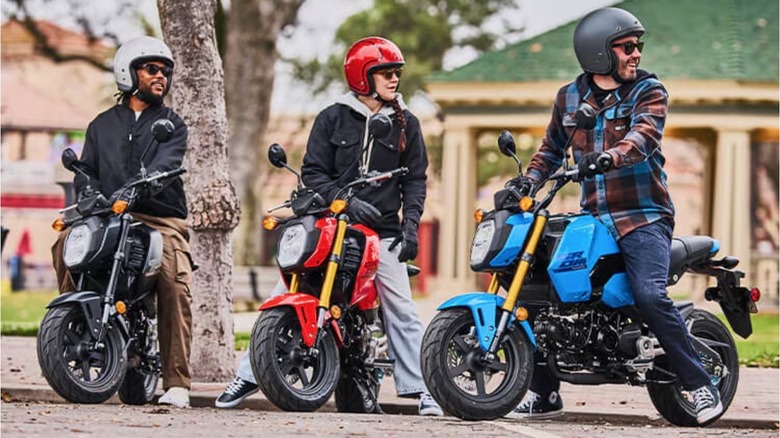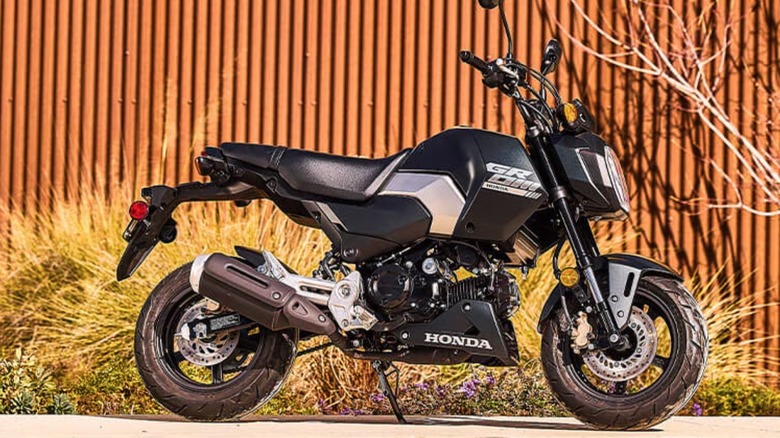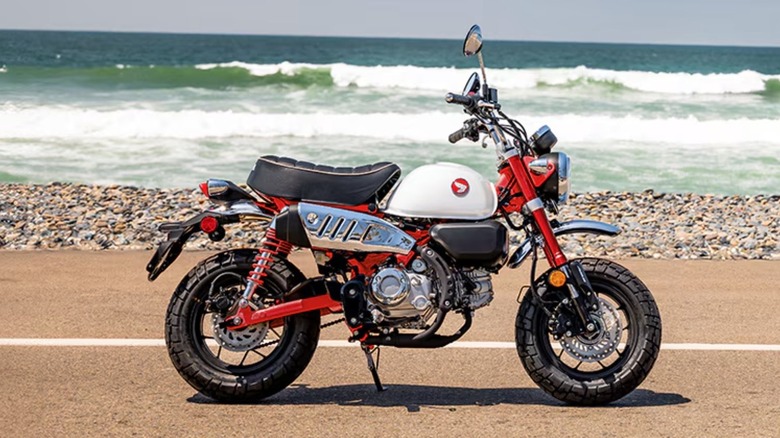Honda Grom Vs. Monkey: How Do These Mini Motorcycles Compare?
While Honda is arguably better known today for manufacturing some of the most durable and fuel-efficient four-wheeled vehicles on the road, it's worth noting that the Japanese company actually got its start building vehicles with two wheels. Indeed, the company started in 1948 as a manufacturer of bicycle auxiliary engines and released its first in-house motorcycle a year later.
Over the decades, Honda has gone on to manufacture a broad lineup of bikes fit for tackling roadways, race tracks, and off-road terrain. They've even developed a line of miniature motorcycles built for casually cruising about town or jetting from one end of the beach to the next. These days, Honda's miniMOTO lineup includes a couple of slick little builds called the Grom and the Monkey, each of which will help you get around town in high style, and currently rank among the best street-legal minis around.
Of course, if you've even casually glanced at either of those Honda miniatures online or in person at a dealership, you know the Grom and the Monkey boast decidedly different styles on the design front, with the former having a decidedly modern look and the latter going for a more retro-inspired concept. However, the differences in the miniMOTO machines stretch beyond the cosmetic. Here's a closer look at how Honda's Grom and Monkey miniature motorcycles compare.
Honda Grom
We'll begin with the Honda Grom, as it is the cheaper of the miniature motorcycles at the base-level build, which will run you a very reasonable $3,599. That price alone has made the sports-bike inspired Grom rank among the most affordable bikes on the market in 2024. Combined with its obvious cool factor, the wallet-friendly price has helped make the bike a popular and long-standing addition to Honda's motorcycle lineup, with the Grom having made its debut in 2014.
While the bike is deemed street legal in all 50 U.S. states, it seems Groms are not certified for highway use in certain states like California, which require vehicles to have at least a 150cc engine for use there. Given that the Grom's 124cc engines tend to top out at 55 mph, it might be a good idea to avoid using them on the freeway even in states where they are permitted. In any case, you'll need to verify the Grom's freeway legality in your state before you hit the on-ramp.
Apart from the pint-sized Grom's surprisingly solid displacement, the miniMOTO's power output is bolstered by Programmed Fuel Injection, a feature that also helps with fuel efficiency, with Honda claiming this 224-pound build is capable of hitting 166.5 miles per gallon. The Grom's low-to-the-ground 30-inch seat height likely makes it easier to control for experienced riders and neophytes alike, and the bike's single-shock setup should deliver a smooth enough ride for either faction. Meanwhile, the Grom's multifunction digital display rounds out its modern stylings.
Honda Monkey
Style is the biggest difference between these Honda builds, and if style is what you're most interested in when it comes to miniature motorcycles, you might be hard-pressed to find one quite as cool as the retro-inspired Monkey. As it is, the bike's retro looks are not just Honda's stab at boosting its curb appeal. In fact, the Monkey's retro look is far more authentic, as the build made its debut in the early 1960s as an amusement park feature fit for adult and child riders alike.
Monkeys have seen all manner of upgrades and redesigns since riding out of the amusement park scene, though the current models arguably look more like those from the 1970s than any other era. Whatever the case, the bike's old-school style is likely a big part of why it costs a little more than the Grom, with base-level models running $4,349. There is, perhaps, another big reason for the price difference, as Honda Monkeys come standard with anti-lock brakes (or ABS for short), a feature that is only available on more expensive trims of the Grom.
Like the Grom, however, Monkeys also come stock with Programmed Fuel Injection, a 5-speed transmission, and a 124cc engine, with the last factor meaning you'll face some of the same highway legality concerns. While the builds are roughly the same size, the Monkey is just a little taller and heavier than its counterpart. Honda equips Monkeys with a twin-shock setup to help smooth out the ride, with an analog-inspired digital speedometer adding to its vintage appeal.


